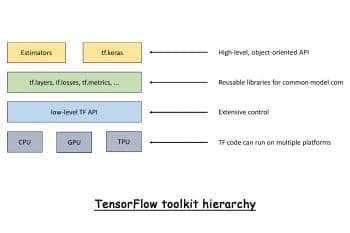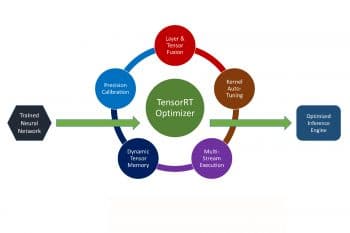AI is playing an increasingly vital role in helping to tackle the global crisis that has arisen from the COVID-19 pandemic. The scope of services that can be provided by AI is wide. From diagnosis to prediction, from clearing doubts to assessing risks, from identification to the delivery of food and services, AI has an important role to play in a pandemic.
Artificial intelligence (AI), also known as machine intelligence, is acquired by computing machines in order to complete any task that requires human intelligence. With the help of free and open source software (FOSS) tools and using advanced AI hardware, it’s possible to develop various AI products that can be used to manage a pandemic. In China, the COVID-19 outbreak was managed using various AI products and services.
During a pandemic, there is a need to develop special software to suit situations that are continuously evolving. The development cycle, as elaborated below, is a standard.
The collaborative development model
Developing any software including AI involves the designing and coding of various modules, which requires more than one software engineer, especially if it’s a large project and needs to be completed in time. In such a case, a collaborative model of software development is useful. This is done by distributing the development activity among various people involved in the project. In this model, the development of software is done in five different stages.
In the beginning, the customer or end user expresses the need for particular software, and the responsibility for communicating with the user is assigned to some people involved in the project. After determining the requirements, the planning for the software development is done in the second stage, with software engineers and programmers communicating with each other. This stage includes creating flowcharts, documentation and planning the timeline for the software development.
After everything is planned, the software engineers assigned for the third stage (modelling) of the project start working. At this stage, a basic working prototype of the planned software is created. Then comes the fourth stage, which is called construction, and this is when the actual software is designed and coded. The software testing is also done at this stage by software testers. On successful testing, the software is taken to the fifth and the final stage, which is deployment – where it is released to the customer or end user for use. After the user runs the software, the feedback is collected. If any error is found, then the software development process goes to another iteration of the same development cycle.
The use of AI models helps develop an effective AI system, with collaboration not only between humans, but also with machines. In this model, various machines are connected with each other using a cloud based network, and the actual data is stored on the cloud and securely exchanged between nodes. With this model, the connected AI machines can communicate with each other and develop the learning process. Humans can also develop the algorithms stored on the cloud network by following the collaborative model of software development.
FOSS tools for AI
There are various FOSS tools available for the development of AI systems. TensorFlow, Keras, Caffe, OpenNN, Theano, Mycroft and TensorRT are some examples of them. Among these tools, TensorFlow and TensorRT are best known for their use in the development of advanced AI systems like autonomous machines.
TensorFlow
This is a FOSS library for data flow and differentiable programming across a range of tasks. It is a symbolic maths library, used for machine learning applications such as neural networks. It is used for both research and the development of various AI systems. Google has used TensorFlow for the development of its various products.
Developed by the Google Brain team for internal use, it was released under the Apache License 2.0 on November 9, 2015. TensorFlow is available on 64-bit Linux, MacOS, Windows, and mobile computing platforms including Android and iOS. In May 2016, Google announced its Tensor Processing Unit (TPU), an application-specific integrated circuit (a hardware chip) built specifically for machine learning and tailored for TensorFlow. It’s like an AI accelerator and Google has used TPUs in its data centres also. TensorFlow is an end-to-end open source platform for machine learning and is a rich system for managing all aspects of an ML system.
TensorFlow APIs are arranged hierarchically. The high-level API is object-oriented and called tf.keras. It is another API variant of the FOSS tool Keras, and can be used to train machine learning models to make predictions. The TensorFlow toolkit also contains reusable libraries that can be used for learning algorithms. The low-level API of TensorFlow is used by many machine learning researchers to create and explore new ML algorithms. With the help of the toolkit, it is possible to create machine learning algorithms that can run on the CPU, GPU and TPU.
TensorRT
This is a free tool from Nvidia that comes as an SDK for the development of high-performance deep learning inference. It includes a deep learning inference optimiser and runtime that delivers low latency and high-throughput for deep learning inference applications. The applications created with TensorRT work 40x faster than CPU-only platforms during inference. TensorRT can let you optimise neural network models that are trained in all major frameworks, calibrate them for lower precision with high accuracy and finally, you can deploy them on data centres, embedded systems or any automotive product.
TensorRT is built on Nvidia’s CUDA platform, which is an API for developing AI systems and enables you to optimise inference for all deep learning frameworks — leveraging libraries, development tools and technologies in CUDA-X for artificial intelligence, autonomous machines, high-performance computing, and graphics. TensorRT provides INT8 and FP16 optimisations for production deployments of deep learning inference applications such as video streaming, speech recognition, recommendations and natural language processing.
TensorRT has an optimiser that can do precision calibration, layer and tensor fusion, kernel auto-tuning, multi-stream execution and dynamic tensor memory handling. TensorRT optimises the trained neural network to get an optimised inference engine, and makes it possible to train AI machines efficiently.
AI medical assistance apps
Many apps linked with AI systems can be helpful during a pandemic. AI based apps that can give medical assistance and keep track of infected individuals are useful in such situations. There are many cloud based apps available that can give medical assistance but without AI, such apps won’t be able to predict the worst-case scenarios during a pandemic.
AI based apps can improve themselves and find better ways to handle newer situations. Such medical assistance apps can give appropriate guidance to the patients according to the level of severity, and some apps with chatbots will even be able to communicate with every individual without the need of any human intervention. The Software as a Service (SaaS) cloud system with AI can be used to give such medical assistance with the help of smartphone apps or any Web based application.
During the COVID-19 pandemic in China, apps like Jingdong and Wei Yi provided online medical consultation services to patients. These apps work through a cloud based AI system. Some AI apps like KardiaMobile 6L and TeleICU were also used during the pandemic to monitor patients.
A company called AliveCor has launched KardiaMobile 6L, an AI-enabled platform, that allows healthcare professionals to measure QTc (heart rate corrected interval) in COVID-19 patients. The QTc measurement can help to determine the probability of sudden cardiac arrest. The AI platform has been developed based on the FDA’s recent guidance to allow more availability of non-invasive remote monitoring devices for the pandemic. Another company, called CLEW, has launched the TeleICU and uses AI to identify respiratory deterioration in advance. Pneumonia is the most common complication of the COVID-19 infection, but with the help of AI, it’s now possible to detect pneumonia by analysing a CT scan in less than 60 seconds, with accuracy as high as 92 per cent and a recall rate of 97 per cent on test data sets. This was made possible in China by an open source AI model that analysed CT images and not only identified lesions but also quantified them in terms of number, volume and proportion.
Therefore, with the help of FOSS tools, it’s possible to create such AI medical apps that can help during a pandemic.
The use of autonomous robots, vehicles and drones during a pandemic
Using service robots can also help people during any pandemic. As robots do not get infected, they can be deployed to help people with any kind of infection. During the COVID-19 pandemic, hospitals in China at Guangdong province used service robots to deliver medicines and communicate with the infected patients. Autonomous vehicles are also useful during any pandemic because they do not need a human driver. Such vehicles use varieties of sensors like radar, lidar, sonar, GPS, odometry and inertial measurement units, along with AI algorithms, to drive from one place to another autonomously. During any pandemic, public transport gets suspended to prevent the spread of infection. In such a crisis, autonomous vehicles can be useful for the transfer and delivery of essential goods. Autonomous drones can also be used to deliver essential goods like food and medicines to people during a pandemic. Such drones use AI and GPS to auto-navigate, and can deliver goods to a predefined location. Drones can also be used for the surveillance of huge gatherings and monitor restricted places during a pandemic.
All such autonomous machines like service robots, vehicles and drones can work together using a collaborative development model. This will enable autonomous machines to learn and exchange data efficiently using an AI cloud. With the help of many FOSS tools like TensorRT and hardware like Nvidia AGX, it’s possible to create efficient autonomous machines that can help during a pandemic.














































































